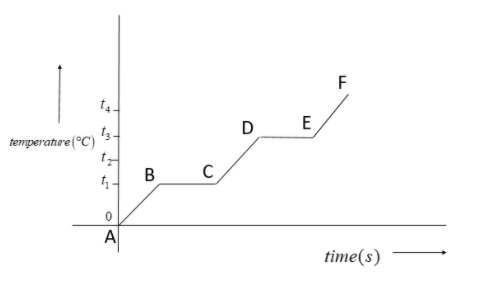Answer
431.4k+ views
Hint: The temperature of a substance always increases with the increase in the surrounding temperature. In case of state change of the material, the temperature of material remains constant with increase in temperature. There are two state changes involved with any material.
Complete answer:
It is well known by all of us that the temperature of a body increases as we apply heat to it. In other words, the temperature of the body increases with the increase in the temperature of the surrounding. But it is also a known fact that as the body undergoes state change, be it from solid to liquid, liquid to gas or vice versa, the temperature of the body remains constant even when we supply heat energy to the body.
There is a very concrete reason to support this fact. The energy we supply to a given body, when the body is undergoing state change, is not utilized to increase its temperature. Rather, this energy is used to undergo state change.
Most of the bodies undergo two basic state changes. These state changes are from solid to liquid and then liquid to gas. When we draw a temperature versus time graph, these state changes will be represented by a horizontal line.
In the given graph, horizontal line BC represents the state change from solid to liquid while the horizontal line DE represents the state change from liquid to gas.
Hence, the boiling point is the point where state changes from liquid to gas. Here this temperature is ${{t}_{3}}{}^\circ C$.
Thus the correct option is (c).
Note:
In a temperature versus time graph the state change of a body is represented by a horizontal line. The first horizontal line will represent state change from solid to liquid, or the melting point. The second one will represent the state change from liquid to gas, or the boiling point.
Complete answer:
It is well known by all of us that the temperature of a body increases as we apply heat to it. In other words, the temperature of the body increases with the increase in the temperature of the surrounding. But it is also a known fact that as the body undergoes state change, be it from solid to liquid, liquid to gas or vice versa, the temperature of the body remains constant even when we supply heat energy to the body.
There is a very concrete reason to support this fact. The energy we supply to a given body, when the body is undergoing state change, is not utilized to increase its temperature. Rather, this energy is used to undergo state change.
Most of the bodies undergo two basic state changes. These state changes are from solid to liquid and then liquid to gas. When we draw a temperature versus time graph, these state changes will be represented by a horizontal line.
In the given graph, horizontal line BC represents the state change from solid to liquid while the horizontal line DE represents the state change from liquid to gas.
Hence, the boiling point is the point where state changes from liquid to gas. Here this temperature is ${{t}_{3}}{}^\circ C$.
Thus the correct option is (c).
Note:
In a temperature versus time graph the state change of a body is represented by a horizontal line. The first horizontal line will represent state change from solid to liquid, or the melting point. The second one will represent the state change from liquid to gas, or the boiling point.
Recently Updated Pages
Mark and label the given geoinformation on the outline class 11 social science CBSE

When people say No pun intended what does that mea class 8 english CBSE

Name the states which share their boundary with Indias class 9 social science CBSE

Give an account of the Northern Plains of India class 9 social science CBSE

Change the following sentences into negative and interrogative class 10 english CBSE

Advantages and disadvantages of science

Trending doubts
Difference between Prokaryotic cell and Eukaryotic class 11 biology CBSE

Differentiate between homogeneous and heterogeneous class 12 chemistry CBSE

Fill the blanks with the suitable prepositions 1 The class 9 english CBSE

Which are the Top 10 Largest Countries of the World?

Give 10 examples for herbs , shrubs , climbers , creepers

10 examples of evaporation in daily life with explanations

Difference Between Plant Cell and Animal Cell

Write a letter to the principal requesting him to grant class 10 english CBSE

Change the following sentences into negative and interrogative class 10 english CBSE




